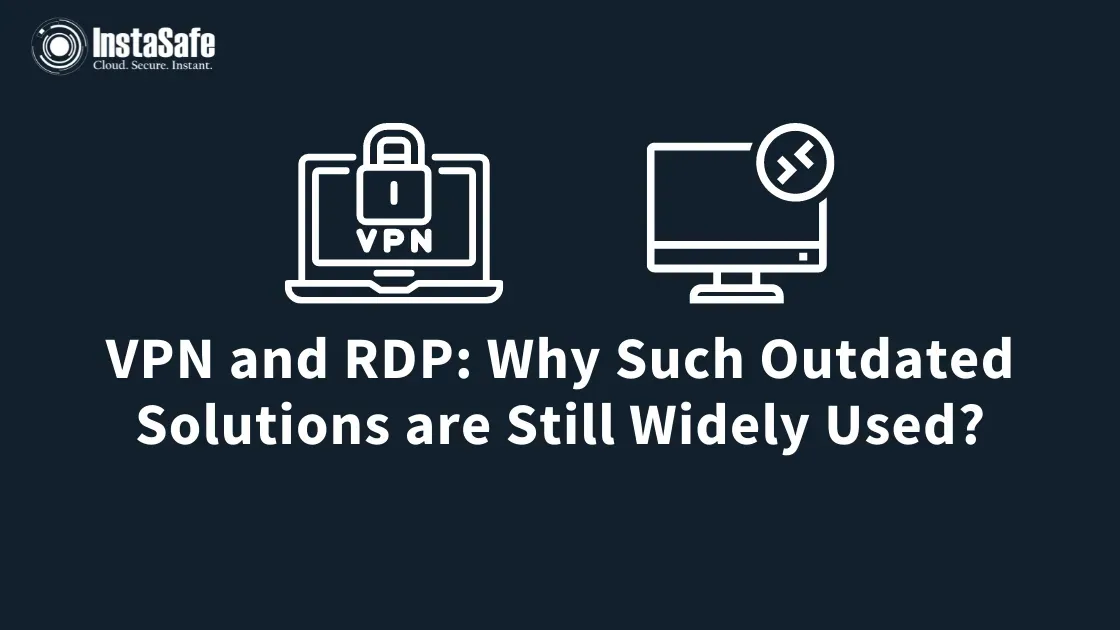VPN and RDP: Why Such Outdated Solutions are Still Widely Used?

Virtual Private Network (VPN) and Remote Desktop Protocol (RDP) are some of the traditional and most commonly used remote access solutions by businesses and organisations.
However, as technology changes and cybercriminals use advanced technologies to access and hack networks—organisations today need more robust and comprehensive network secure and remote access solutions.
Even though VPN and RDP are popular amongst organisations—they’re quite outdated and easy targets of cyberattackers and hackers. In this article, we’ll talk more about these solutions, why organisations still use them, and an alternate solution for VPN and RDP for your organisation’s high network security. Let’s begin!
What is VPN?
A Virtual Private Network has been a preferred solution for organisations for secure remote access for several years. It’s based on perimeter-based security, creates encrypted portals or tunnels through secure network perimeter, and allows remote employees access to network resources and assets.
It creates a secure wide-area network for businesses and organisations and is considered an affordable solution for organisations to link their remote workforce to central computing resources.
Here are some VPN advantages that make businesses use it:
- Sends remote user data and information through encrypted tunnels.
- It’s a scalable solution that meets the needs, security policies, and budgets.
- Finding a compatible VPN solution that integrates with your network’s security and administrative systems is easy.
What is RDP?
Remote Desktop Protocol (RDP) allows you to access a server or a computer over the internet for a complete desktop experience. It initiates a connection between a host computer and the user’s device—allowing the user to control the computer, perform tasks like file transfers, and leverage remote sound, printers, and clipboards with ease.
Network administrators can use an RDP connection to manage data centre servers or perform system maintenance without leaving their office space.
Here are some RDP advantages that make businesses use it:
- It provides straightforward remote access with a shallow learning curve—working seamlessly with virtualisation and network management tools.
- It simplifies and facilitates BYOD management.
- Improves user productivity—giving employees a similar user experience they had in the office.
- Ensures data security as files and applications stay at company-controlled systems.
What Makes VPN and RDP Outdated?
Despite being widely adopted, both RDP and VPN pose greater security risks and cybersecurity threats to an organisation’s networks and resources.
In 2020, total RDP attacks rocketed by a whopping 241% to 3.3 billion attacks from 969 million in 2019.
Here are the disadvantages of using RDP and VPN for your organisation in today’s age:
- Sending desktop monitor access via RDP affects network performance and security and turns your business operations into a video streaming service.
- RDP enables remote connections by relying on publicly visible open ports—providing high visibility to the hackers and cybercriminals.
- If you have a weak or poorly-enforced desktop password—it makes brute-force attacks more effective.
- Similar to RDP, VPNs impact network performance due to high traffic and backhaul issues, resulting in latency and bandwidth congestion.
- Even though you can scale VPNs and prevent hardware limitations by adding VPN solutions in software—it increases overhead costs and gets expensive.
- VPNs come with many deployment challenges and often require reconfiguring the network infrastructure to implement corporate VPN solutions.
- VPNs increases surface attack risks by granting complete access to network resources to every user—making it easy for cybercriminals to access the resources.
So, considering the disadvantages of VPN and RDP, what are the RDP and VPN alternatives you can use for your organisation?
What is an Alternate Solution for RDP and VPN?
One of the highly recommended and best alternates for VPN and RDP solutions is the Zero Trust Security solution.
Zero Trust solution upgrades your organisation’s network security posture and replaces the legacy and traditional security setup with a remote and cloud-ready security solution.
The Zero Trust approach relies on the principle of “Never Trust, Always Verify”—providing access to only authorised and authenticated users to ensure better security, performance, and RoI than VPN and RDP.
Here’s what makes Zero Trust the best alternative for VPN and RDP.
- Zero Trust assumes the users to be already compromised, granting access only after a strict authentication and authorisation process to specific resources.
- Minimises security risks and surface attacks by implementing least privilege access and user-role based access solutions.
- Extends security to your organisation’s cloud assets and prevents lateral movement for enhanced security.
- Implements a simple and unified secure remote access solution by removing the redundant VPN management complexity.
- Provides granular user activity access and control over which users can access what assets and resources within the network.
- Ensures high user experience by eliminating backhauling and network latency issues with seamless single-click access.
Conclusion
Even though RDP and VPN solutions have been around for decades and makeup to be easy solutions for remote access—they’re highly vulnerable to security attacks and can expose your organisation’s network with a large attack surface.
Thus, if you want to improve network security and ensure robust and secure remote access—check out our InstaSafe solutions. We ensure the utmost network security of your organisation with our reliable and affordable Zero Trust solutions. So, get in touch with us or book a demo today to learn more.
Key Products
MFA | I&AM | ZTNA | Zero Trust Application Access | Secure Enterprise Browser
Key Features
Single Sign On | Endpoint Security | Device Binding | Domain Joining | Always On VPN | Contextual Based Access | Clientless Remote Access | Device Posture Check
Key Solutions
VPN Alternatives | DevOps Security | Cloud Application Security | Secure Remote Access | VoIP Security
